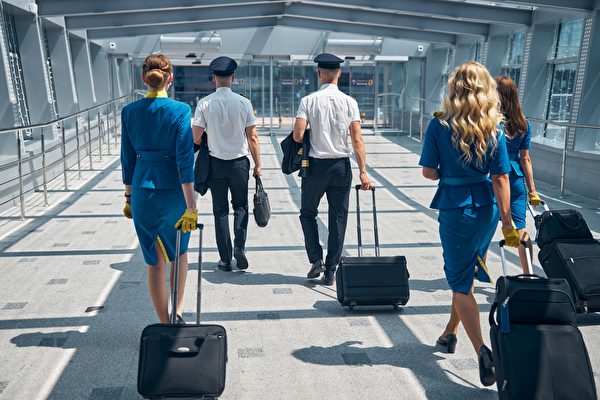Airline crew members, including pilots and flight attendants, must work shifts, with varying duty hours that can include late nights or early mornings—a far cry from the typical 9-to-5 work schedule. So, how many flights do flight attendants who interact directly with passengers complete in a day?
According to aviation news website “Simple Flying,” the number of flights flight attendants complete in a day varies significantly depending on the region, type of flight, and airline. For flight attendants in the United States, there are generally two types of scheduling:
(1) Reserve flight attendants have no fixed schedule and are on call 24 hours a day to accommodate any last-minute flight assignments—an arrangement often applicable to newly hired staff. Their flight schedules are not fixed.
(2) Line-holder flight attendants, who are more experienced, have some flexibility in their schedule, such as choosing work dates, times, and destinations. They can also request shift swaps or to fly with specific colleagues of their choosing.
On average, domestic flight attendants in the United States work 12 to 14 days per month, accumulating flight hours ranging from 65 to 85 hours. Delays or cancellations are possible occurrences. While they may have one flight per day, typically they have two, up to a maximum of six flights per day, depending on operational factors.
Long-haul flights refer to international routes with flight durations extending over several hours and spanning more than three days. The varying schedules for each flight and airline make these assignments hard to predict.
As per regulations from the Federal Aviation Administration (FAA) in the United States, flight attendants must have a minimum of 9 hours of rest if their work exceeds 14 hours and 12 hours of rest for work periods exceeding 18 hours.
FAA regulations specify the number of flight attendants required based on the number of passengers on the aircraft, ensuring they receive adequate rest during long-haul flights. The scheduling of flight attendants heavily depends on their seniority. With increased seniority, they can even request to avoid working on specific flights.
Flight attendants in Europe and the Middle East typically work 16 to 22 days per month, with specific hours determined by the airline and contractual agreements. Most airlines (including charter and low-cost carriers) have flight attendants working two flights per day.
At low-cost carriers, flight attendants usually have two flights per day, with a maximum of four flights. These are round-trip flights, and unless due to technical issues, they do not overnight at the destination. The turnaround time between these flights is very short, allowing for up to six short-haul round trips in a day. These flight attendants often have families and prefer staying home every night, making this arrangement suitable for them.
Regular flight attendants handle a variety of responsibilities on their schedules, including round trips, overnight layovers, standby duties (at home or at the airport), and split duty (overnight at an outstation). Split duty involves short-haul return flights, where flight attendants take the last flight of the night to a city, rest in a hotel near the airport for about 6 hours, and then take the first flight back the next morning.
Flight attendants on short-haul flights typically work for 5 to 6 days with a 2 to 3-day break. They work 5 to 12 hours per day, handling one to four flights.
Flight attendants on long-haul flights typically fly five to six flights per month, with standby duties and approximately 10 days of leave. These flights always include overnight stays at a destination, with only one flight per day. Flight durations vary from 7 to 15 hours, with a round trip taking 3 to 10 days. During flights, flight attendants are required to rest for 1 to 4 hours.
Standby is a routine task for flight attendants, where they must be in uniform and ready for duty on the aircraft at any time to cover for colleagues who may be sick or late. When called in to substitute, they are informed about which flight they should board.
It’s important to note that flight attendants’ schedules often change due to flight delays. Airlines rigorously monitor their work hours to comply with flight time limitations, which include a maximum of 100 flight hours within 28 days and 900 flight hours within 12 months.
Here is an example schedule for a long-haul flight:
– London to Dubai (overnight stay, 12 hours), Dubai to London (next day).
– Rest for 2 days.
– London to Singapore (stay for two nights), Singapore to Sydney (stay for one night), Sydney to Singapore (stay for two nights), Singapore to London.
– Rest for 4 days.
– London to New York (overnight stay, 12 hours), New York to London (overnight stay, 12 hours), London to Boston (overnight stay, 12 hours), Boston to London.
– Rest for 2 days.
– London to New Delhi (stay for one night), New Delhi to London (next day).
– Rest for 1 day.
– London to Beijing (stay for one night), Beijing to London (next day).
Some major international airlines combine short-haul and long-haul routes for their flight attendants, with the number of flights per day, monthly work hours, and rest days remaining quite similar.
Additionally, some flight attendants serve VIPs on private aircraft. Private planes do not necessarily have flight time restrictions; instead, these flight attendants operate on a more flexible schedule dictated by the region, operator, and aviation authorities. Thus, they have less restrictions on working hours or daily flight frequency.
These flight attendants are on call and work without a set schedule, sometimes operating on a rotating basis. They may work for 14 days first and then take 14 days off, or work for a month followed by a month off.
In conclusion, the number of specific flight tasks flight attendants must complete each day largely depends on the airline they work for and their location. While the basics may be similar, there are considerable differences.

